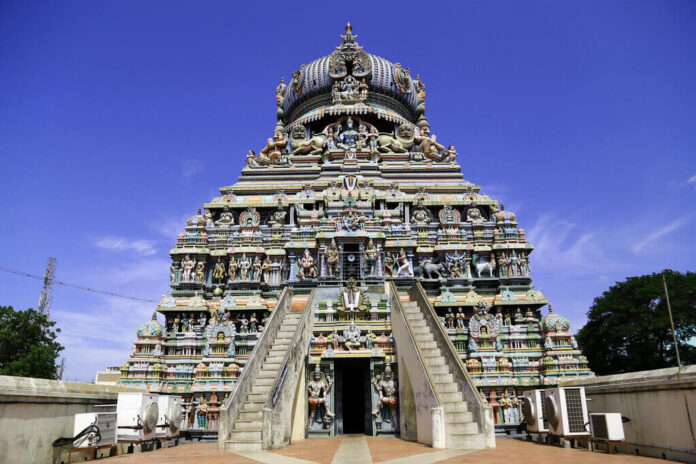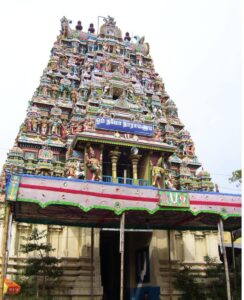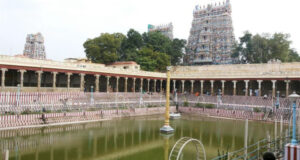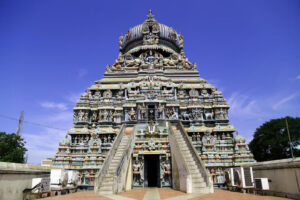Koodal Azhagar Temple, Madurai:
The Hindu deity Vishnu is the focus of the Koodal Azhagar Temple in Madurai, which is located in the Tamil Nadu state of South India. Built in the Dravidian architectural style, the temple is revered in the Naalayira Divya Prabandham, the early medieval Tamil canon of the saints of Alvar, which dates from the sixth to the ninth century CE. Known as Viyooga Sundarrajan and his consort Lakshmi as Mathuravalli, it is one of the 108 Divya Desams devoted to Vishnu.
Koodal Azhagar Temple History:
The Koodal Azhagar temple’s shrines are all enclosed by a stone wall. The gateway tower, or rajagopuram, has five tiers within the temple. The Pandyas are thought to have constructed the temple at first, with later extensions made by the Vijayanagara empire and the Madurai Nayak monarchs, who ordered the construction of the temple’s main shrines and pillared halls in the sixteenth century.
An inscription from the eighth century mentions granite stones donated for Ardha Mandapa’s construction. In the sixteenth century, when the Madurai Nayaks ruled, the temple was enlarged. The Nayaks built the Dvajasthambam mandapam (flag staff) and mandap prior to the Hema Pushkarani. Muthu K.R.V. Alagappa Chettiar of Devakottai built the Mathuravalli Thayar Shrine (Thayar) and refurbished it in 1923. The Hindu Religious and Charitable Endowments Department of the Tamil Nadu government has been in charge of the temple’s upkeep and management ever since.
Legend of Koodal Azhagar Temple:
According to Hindu mythology, Vallabhadeva, a ruler, would go undercover every day to learn about the lives of those under his authority. The ultimate purpose of life, according to a scholar he met during one of his visits, is to “collect provisions in summer and save for winter,” which also implies working while one is young and saving for old age. Not having been persuaded, Vallabadeva turned this into a contest between academics in an attempt to awaken him to the actual worth of life. Arriving in Madurai from Srivilliputhur was Vishnucitta, who would become Periyalvar, one of the twelve most venerated saints of the Vaishnava cult.He was said to have explained the holy passages under the guidance of Vishnu’s celestial utterances. He declared that reaching the feet of Narayana could result in redemption and he elucidated the ideas of Hitham and Purushartham from the Vedas. After receiving a satisfactory explanation, Visnucitta was given a bag of gold by Vallabhadeva. It is thought that Periyalvar used the riches he had won to construct the gopuram that stands today at Srivilliputhur Temple.
Koodal Azhagar Temple Timings:
The Koodal Azhagar temple’s darshan timings are from 5:30 pm to 12:00 pm . It opens in the evening from 4.00 pm to 9 p.m.
Architecture of Koodal Azhagar Temple:
The Koodal Aḻagar temple is spread across around 0.81 hectares or 2 acres and features a five-tiered gopuram, or gateway tower, that rises to a height of 125 feet (38 meters). Huge granite walls enclose the rectangular enclosure that houses the temple. The images of Koodal Aḻagar, the presiding god, are housed in the elevated central shrine in three different poses: sitting, standing, and reclining.The granite picture stands six feet (1.8 meters) tall and is posed in a seated position. On either side of Koodal Aḁagar are images of Sridevi and Bhudevi. The four feet (1.2 meters) tall picture of the festival deity, Vyuga Sundararajar, is crafted from panchaloha.With eight components—Adhistana (foundation), three Padas (structural elements), Prashthana (limb), Griva (leading structure), Shikara (cylindrical holding), and Stupi (upper portion)—the vimana, the shrine over the sanctum, is an example of Ashtanga architecture. Stucco images of sages Dashavataram, Bhudevi and Varaha, Lakshmi Narasimha, Lakshmi Narayana, and Narayanamoorthy adorn the exterior of the vimana. The celestial architect Vishvakarma is said to have created the vimana. The vimana’s shadow does not descend to the earth. The temples of Mannar Koil, Ambasamudram, Uthiramerur, Thirukoshtiyur, and Cheranmadevi are home to the Ashtanga Vimana. The Ashtadikpalakas are depicted in murals on the sanctum’s interior walls.To the south of the main shrine lies the shrine dedicated to Mathuravalli, Koodal Aṁagar’s consort. Near the sanctum are a few smaller temples dedicated to Lakshmi Narasimha, Rama, Lakshmi Narayana, and Krishna. Separate shrines housing the images of Andal, Narasimha, and Manavala Mamunigal may be located in the vicinity of the first perimeter. There are paintings of puranic stories and inscriptions describing devotional literature at the shrine of Andal. The second precinct has the shrines of Garuda, Anjaneya, Ramanuja, Vedanta Desika, and Alvars. In the second precinct, there are little sculptures on the pillars that lead to the sanctum. A shrine honoring Suryanarayana is located on the second floor, surrounded by goddesses.The temple tank, Teppakulam, is situated beyond the walls of the temple. Its center hall is composed of granite.
Koodal Azhagar Temple Address:
Koodal Alagar Perumal Koil Street, Pallivasal Ln, Near Periyar Bus Stand, Periyar, Madurai Main, Madurai, Tamil Nadu 625001.
Koodal Azhagar Temple Contact Number – 0452-2338542
Festivals Celebrated at sri koodal azhagar temple:
The Tenkalai sect of Vaishnavite tradition and the Vaikasana aagama are adhered to by the temple. Pujas, or rites, are being performed by temple priests on a daily and festival basis. Similar to other Vishnu temples in Tamil Nadu, the priests are members of the Iyengar Vaishnavaite community. Six times a day are dedicated to temple rituals: 8:00 a.m. for Kalasanthi, 12:00 p.m. for Uchikalam, 5:00 p.m. for Sayarakshai, and 6:00 p.m. for Aravanai Pooja. For both Koodal Aṁagar and Mathuravalli, each ritual consists of three steps: alangaram (decoration), neivethanam (food offering), and deepa aradanai (waving of lamps). The last act of worship involves the playing of the nagaswaram (a pipe instrument) and tavil (a percussion instrument), priests reciting passages from the Vedas (a sacred text), and worshipers prostrating themselves in front of the monument. The temple performs weekly, monthly, and fortnightly rites.
The temple’s most notable event is the fourteen-day yearly Brahmotsavam, which takes place during the Tamil month of Vaikasi (May–June). Throughout the entire fourteen-day period, the temple’s celebratory images are wheeled around the streets on a variety of mounts.
How to reach Koodal Azhagar Temple:
The “Madurai Junction Railway Station,” which is one kilometer away from this temple, is the closest train station. You can use a bus, cab, or auto rickshaw to travel this distance.
Additionally, “Madurai International Airport,” which is 11.2 kilometers from this temple, is the closest airport.
Koodal Azhagar temple to Meenakshi Temple – 6 min (1.2 km) via Netaji Rd
koodal azhagar temple to bangalore – 7 hr 47 min (435.8 km) via NH 44
koodal azhagar temple to madurai distance – 9 min (1.8 km) via W Masi St
koodal azhagar temple to ernakulam distance – 7 hr 7 min (265.0 km) via NH85
koodal azhagar temple to guruvayur temple distance – 6 hr 43 min (316.4 km) via NH 83
Koodal Azhagar Temple Images:




